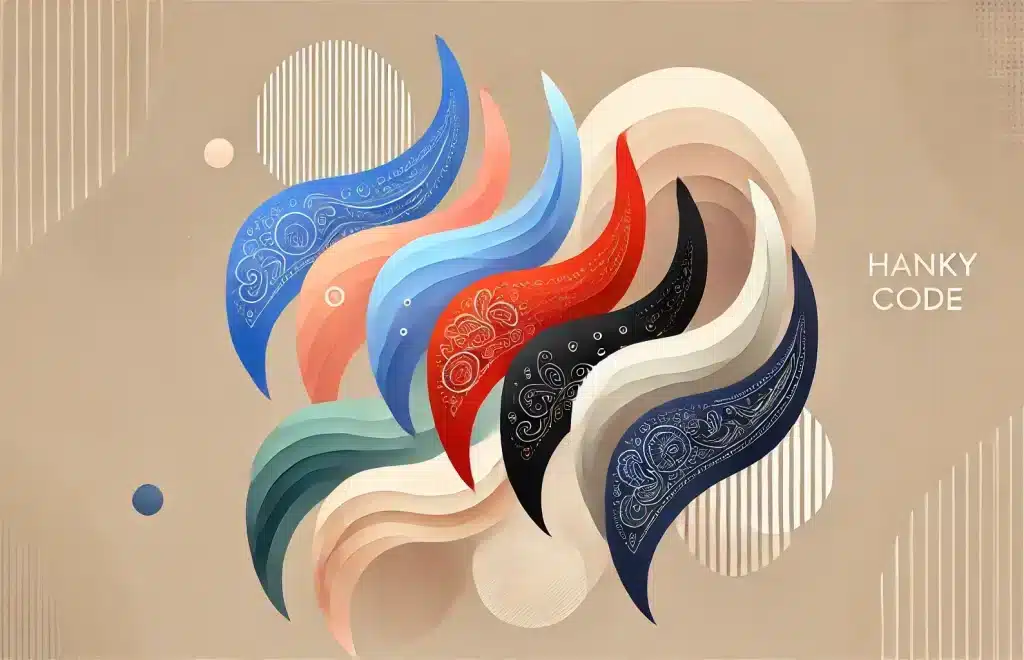Click a color to reveal its meaning in the hanky code:
Have you ever noticed a man with a colored bandana or handkerchief sticking out of his back pocket during a gay party or Pride event? There’s a good chance he was trying to send you a message…!
In the 1970s, there were no Grindr profiles to showcase people’s preferences or how they liked things. Even if the app had existed, most gay men wouldn’t openly say anything for fear their mother or boss might find out. This also applied to the kink scene.
So, these sexual pioneers developed a secret language using handkerchiefs in their pockets. This became known as the hanky code, handkerchief code, or bandana code.
Colors and patterns: from fisting to celery
The color or pattern of the handkerchief was a signal for a preferred sexual activity. There was no universal code, so meanings could vary by region. However, there was some consistency with common preferences or colors that had clear associations with certain activities.
The list goes on. There are many other colors, but shades of green, blue, and pink can sometimes be tricky to interpret. Before you take someone home, it’s worth having a chat to make sure you don’t confuse magenta with fuchsia or teal with light green. Think of the handkerchief as an invitation to learn more about the person.
The code wasn’t limited to solid-colored bandanas either. Printed patterns, materials, or even objects could signal sexual preferences. Some curious examples include tampons (for menstruation blood enthusiasts or menstruators), celery (suggesting brunch after sex), and USB cords (for those who blog about their sex life).
Dominant or sub, top or bottom, left or right
Where the bandana was worn also mattered. It was typically seen in a back pocket or sometimes tied around the arm. Generally, a top or dominant person would wear it on the left, while a bottom or sub would wear it on the right. For example, a red handkerchief worn on the left signaled the wearer was into fisting, while wearing it on the right meant they wanted to receive.
Bandanas could also be worn in the front or back of the pants, around the neck (with the knot on either side), around the ankle, or elsewhere on the body. A versatile person might wear the bandana around their neck without a knot.
Hanky history
There are several theories about how the hanky code started. One story comes from San Francisco in 1852, during the California Gold Rush. Nearly 35,000 men worked as cowboys or miners, and most of them were men. The work was stressful and lonely, so they held singing and dancing evenings to let off steam.
Since there were no women, every man had to take on either the male (leader) or female (follower) role in the dance. To show which role they were willing to play, each man wore a colored bandana: blue for dancing as a man, or red for dancing as a woman.
Fast forward 120 years to the 1970s in New York City, members of the leather community began wearing keys on their belts. If the keys were on the left, they were a top; on the right, they were a bottom.
A journalist at The Village Voice, New York’s first alternative weekly newspaper, jokingly wrote that instead of using keys, people could use colorful handkerchiefs to indicate more specific interests. He might have been inspired by California’s gold rush days.
And so, the hanky code was born; or at least that’s how the story goes.
Today’s hanky code
In the 1970s, the hanky code was widely known among gay and bisexual men, but its use declined in the early 1980s. With today’s digital technologies replacing face-to-face cruising, profile details and search filters on our apps might be the modern equivalent, helping us find perfectly matched partners from afar.
Still, it never hurts to be aware of the color code. You never know when you might meet an interesting guy with a hanky, or have an all-male ballroom dance night. Or when your boss shows up on Grindr… and your mom.
